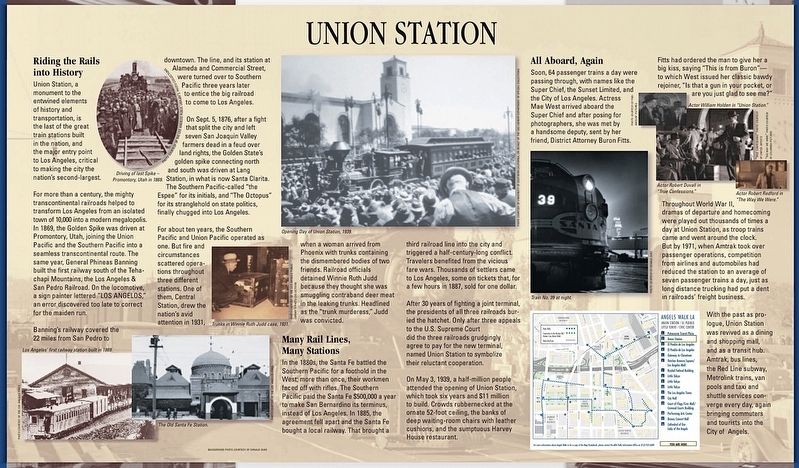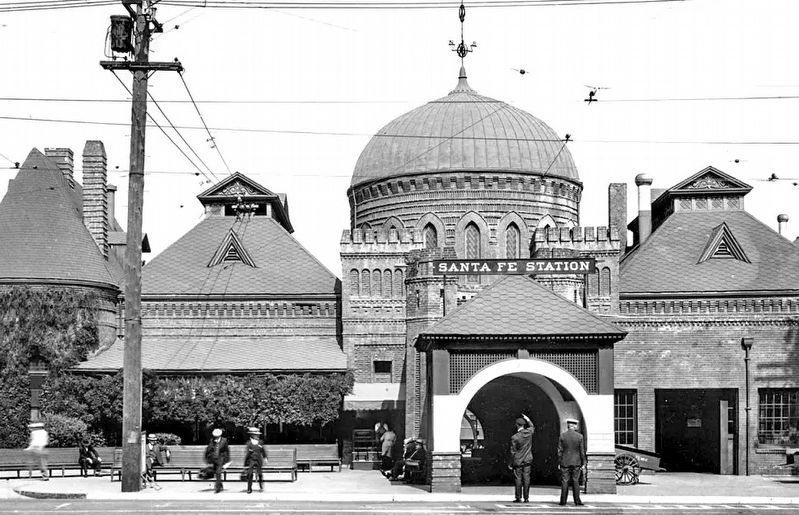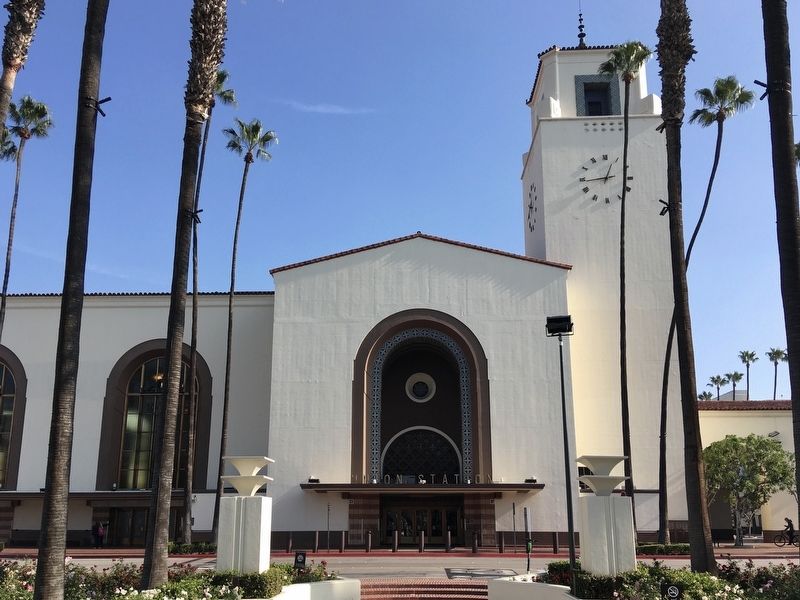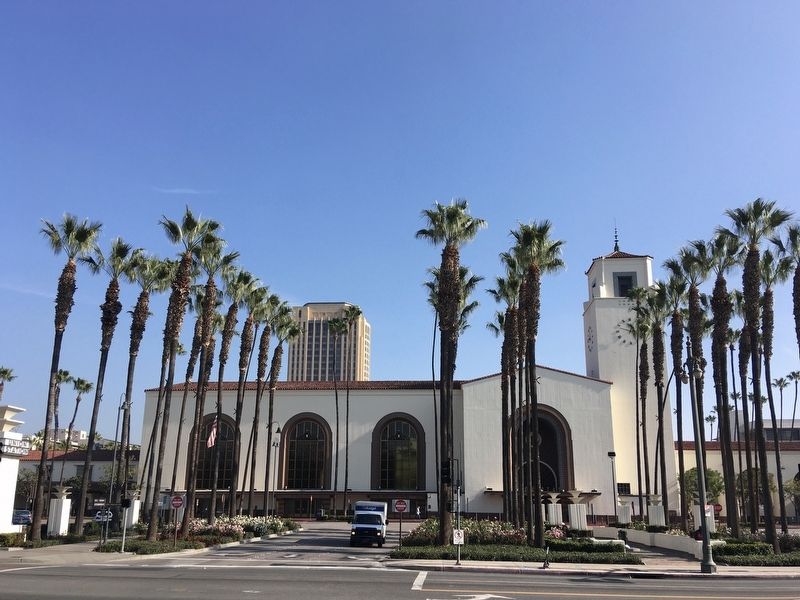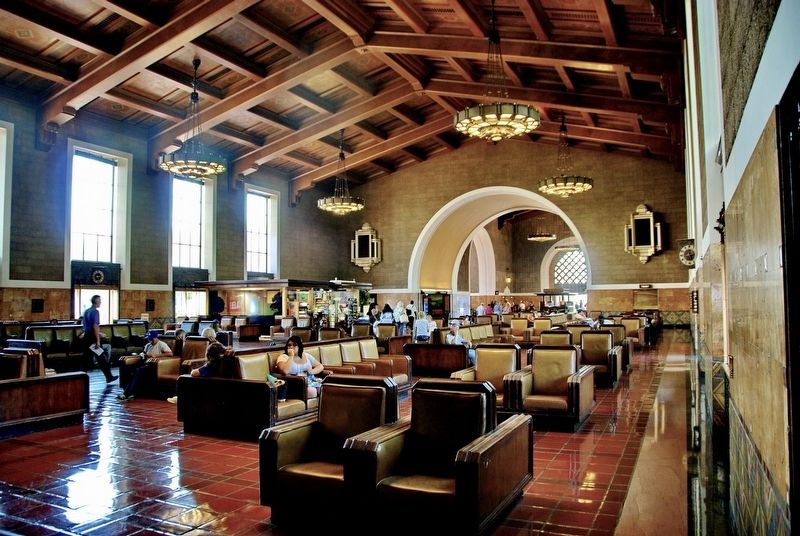Downtown Los Angeles in Los Angeles County, California — The American West (Pacific Coastal)
Union Station
Riding the Rails into History
Union Station, a monument to the entwined elements of history and transportation, is the last of the great train stations built in the nation, and the major entry point to Los Angeles, critical to making the city the nation's second-largest.
For more than a century, the mighty transcontinental railroads helped to transform Los Angeles from an isolated town of 10,000 into a modern megalopolis. In 1869, the Golden Spike was driven at Promontory, Utah, joining the Union Pacific and the Southern Pacific into a seamless transcontinental route. The same year General Phineas Banning built the first railway south of the Teha chapi Mountains, the Los Angeles & San Pedro Railroad. On the locomotive, a sign painter lettered "LOS ANGELOS," an error discovered too late to correct for the maiden run.
Banning's railway covered the 22 miles from San Pedro to downtown. The line, and its station at Alameda and Commercial Street, were turned over to Southern Pacific three years later to entice the big railroad to come to Los Angeles.
On Sept. 5, 1876, after a fight that split the city and lett seven San Joaquin Valley farmers dead in a feud over land rights, the Golden State's golden spike connecting north Doft and south was driven at Lang Station, in what is now Santa Clarita The Southern Pacific-called "the Espee" for its initials, and "The Octopus for its stranglehold on state politics, finally chugged into Los Angeles.
For about ten years, the Southern Pacific and Union Pacific operated as one. But fire and circumstances scattered operations throughout three different stations. One of them, Central Station, drew the nation's avid attention in 1931, when a woman arrived from Phoenix with trunks containing the dismembered bodies of two friends. Railroad officials detained Winnie Ruth Judd because they thought she was smuggling contraband deer meat in the leaking trunks. Headlined as the "trunk murderess," Judd was convicted.
Many Rail Lines, Many Stations
In the 1880s, the Santa Fe battled the Southern Pacific for a foothold in the West; more than once, their workmen faced off with rifles. The Southern Pacific paid the Santa Fe $500,000 a year to make San Bernardino its terminus, instead of Los Angeles. In 1885, the agreement fell apart and the Santa Fe bought a local railway. That brought a third railroad line into the city and triggered a half-century-long conflict. Travelers benefited from the vicious fare wars. Thousands of settlers came to Los Angeles, some on tickets that for a few hours in 1887, sold for one dollar.
After 30 years of fighting a joint terminal, the presidents of all three railroads buried the hatchet. Only after three appeals to the U.S. Supreme Court did the three railroads grudgingly agree to pay for the new terminal, named Union Station to symbolize their reluctant cooperation.
On May 3, 1939, a half-million people attended the opening of Union Station, which took six years and $11 million to build. Crowds rubbernecked at the omate 52-foot celing, the banks of deep waiting room chairs with leather cushions, and the sumptuous Harvey House restaurant.
All Aboard, Again
Soon, 64 passenger trains a day were passing through, with names like the Super Chief, the Sunset Limited, and the City of Los Angeles. Actress Mae West arrived aboard the Super Chief and after posing for photographers, she was met by a handsome deputy sent by her friend, District Attorney Buron Fitts. Fitts had ordered the man to give her a big kiss, saying "This is from Buron" - to which West issued her classic bawdy rejoiner, "Is that a gun in your pocket, or are you just glad to see me?"
Throughout World War II, dramas of departure and homecoming were played out thousands of times a day at Union Station, as troop trains came and went around the clock. But by 1971, when Amtrak took over passenger operations, competition from airlines and automobiles had reduced the station to an average of seven passenger trains a day, just as long distance trucking had put a dent in railroads’ freight business.
With the past as prologue, Union Station was revived as a dining and shopping mall, and as a transit hub. Amtrak, bus lines, the Red Line subway, Metrolink trains, van pools and taxi and shuttle services converge every day, again bringing commuters and tourists into the City of Angels.
Erected 2000 by City of Los Angeles.
Topics. This historical marker is listed in these topic lists: Architecture • Railroads & Streetcars.
Location. 34° 3.388′ N, 118° 14.232′ W. Marker is in Los Angeles, California, in Los Angeles County. It is in Downtown Los Angeles. Marker is at the intersection of Alameda Street and Los Angeles Street, on the right when traveling north on Alameda Street. Touch for map. Marker is at or near this postal address: 800 N Alameda St, Los Angeles CA 90012, United States of America. Touch for directions.
Other nearby markers. At least 8 other markers are within walking distance of this marker. A different marker also named Union Station (within shouting distance of this marker); Bell of Dolores (within shouting distance of this marker); Antonio Aguilar (within shouting distance of this marker); a different marker also named Union Station (within shouting distance of this marker); Placita de Dolores Time Capsule (within shouting distance of this marker); The Indians of Southern California (within shouting distance of this marker); Plaza Substation (about 300 feet away, measured in a direct line); Homage to Our Mexican-American Heroes (about 300 feet away). Touch for a list and map of all markers in Los Angeles.
More about this marker. This interpretive sign has been removed and has not yet been replaced.
Also see . . . Angels Walk L.A. Self-guided walking tours of historic neighborhoods in Los Angeles. This marker is part of the Union Station walk. (Submitted on July 11, 2023.)
Credits. This page was last revised on July 11, 2023. It was originally submitted on July 11, 2023, by Craig Baker of Sylmar, California. This page has been viewed 99 times since then and 18 times this year. Photos: 1, 2. submitted on July 11, 2023, by Craig Baker of Sylmar, California. 3, 4. submitted on January 12, 2021, by Craig Baker of Sylmar, California. 5. submitted on January 13, 2021, by Craig Baker of Sylmar, California.
